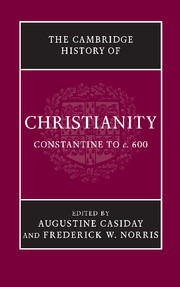Book contents
- Frontmatter
- Introduction
- Part I Christianity: Regional Developments
- Part II Christianity Contested
- Part III Christian Culture and Society
- Part IV Christian Beliefs and Practices
- 18 Discourse on the Trinity
- 19 History of Christology to the seventh century
- 20 Sin and salvation: Experiences and reflections
- 21 From Antioch to Arles: Lay devotion in context
- 22 Saints and holy men
- 23 Pastoral care and discipline
- 24 Sexuality, marriage and the family
- 25 The growth of liturgy and the church year
- 26 Interpreting scripture
- 27 Asceticism and monasticism, I: Eastern
- 28 Asceticism and monasticism, II: Western
- 29 Art and Propaganda fide: Christian art and architecture, 300–600
- Index
- Map 1 The Roman empire, c. 400">
- References
23 - Pastoral care and discipline
from Part IV - Christian Beliefs and Practices
Published online by Cambridge University Press: 28 March 2008
- Frontmatter
- Introduction
- Part I Christianity: Regional Developments
- Part II Christianity Contested
- Part III Christian Culture and Society
- Part IV Christian Beliefs and Practices
- 18 Discourse on the Trinity
- 19 History of Christology to the seventh century
- 20 Sin and salvation: Experiences and reflections
- 21 From Antioch to Arles: Lay devotion in context
- 22 Saints and holy men
- 23 Pastoral care and discipline
- 24 Sexuality, marriage and the family
- 25 The growth of liturgy and the church year
- 26 Interpreting scripture
- 27 Asceticism and monasticism, I: Eastern
- 28 Asceticism and monasticism, II: Western
- 29 Art and Propaganda fide: Christian art and architecture, 300–600
- Index
- Map 1 The Roman empire, c. 400">
- References
Summary
Any attempt to imagine and describe pastoral care in the early church encounters a great many obstacles. The evidence we possess is almost entirely literary, and it is not only fragmentary but also ambiguous. Moreover, we cannot speak of any uniform practice. It is obvious that there are differences both because of conditions that changed over time and because even in a single period pastoral care and discipline varied from place to place. Finally, to speak of pastoral care we ought to understand what it looked like to those who received it. But most of what we can know is told by the pastors themselves. We have pieces of the puzzle, but most of them are lost. Nevertheless, there are some general conclusions that are persuasive. One of them is that pastoral care did not confine itself to Christian morality. The cure of souls involved guiding Christians towards their final destiny in the age to come as well as helping them live the kind of life that would fit them for that destiny. Moreover, pastoral care also involved practical ways of dealing with the basic necessities of this life. Widows and orphans, the poor and the sick, prisoners and captives – all received pastoral care. The care of the body may even have been more obvious to the ordinary Christian than the cure of souls. The pastors who had these responsibilities were, in the first instance, the bishops and their priests and deacons in the cities and their environs. But there were others who also functioned as pastors – monks, holy women, teachers. And we should not forget the care given by ordinary Christians to one another and to those outside the faith. Let us turn first to three paradigms of the pastoral ideal as it was articulated in the fourth century.
Keywords
- Type
- Chapter
- Information
- The Cambridge History of Christianity , pp. 567 - 584Publisher: Cambridge University PressPrint publication year: 2007
References
- 1
- Cited by

